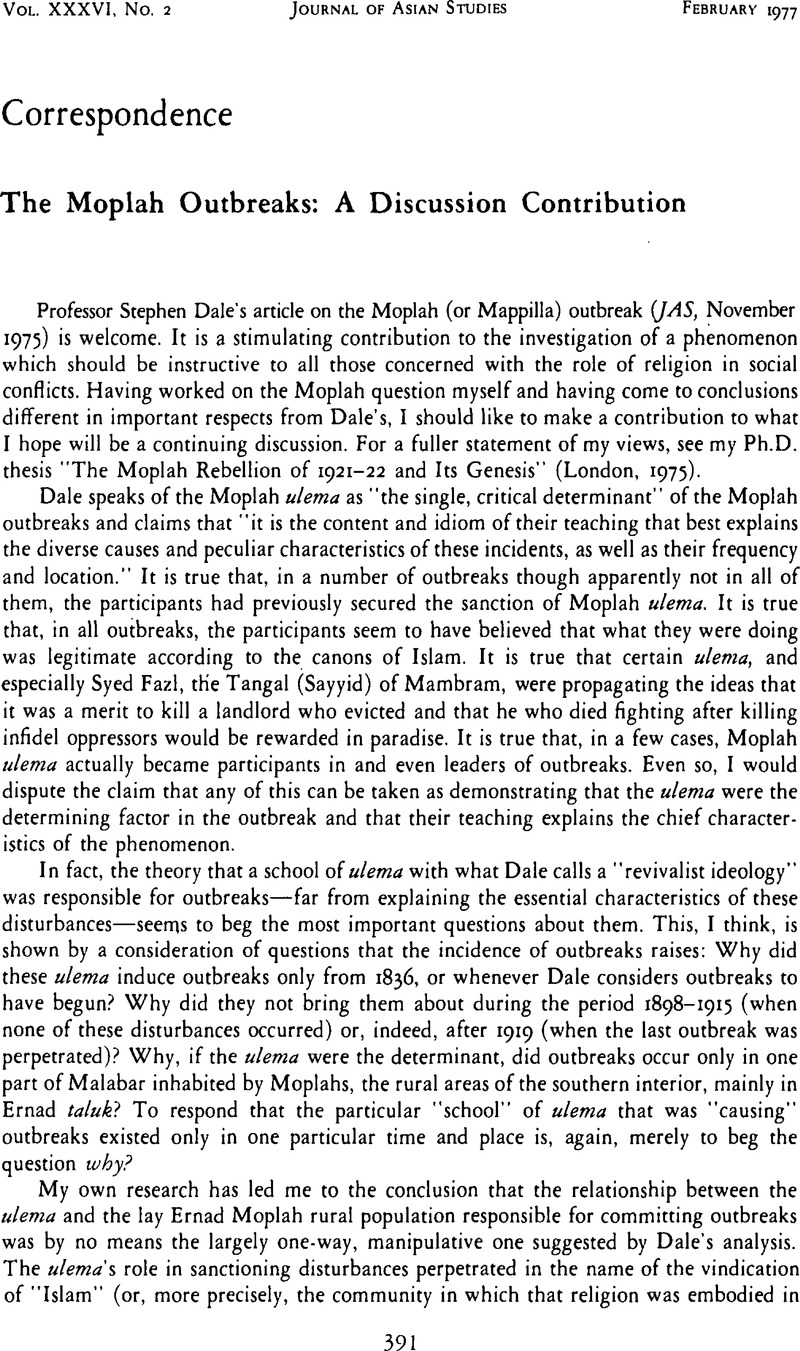No CrossRef data available.
Published online by Cambridge University Press: 23 March 2011

1 To be even more accurate, even certain groups of Ernad Moplahs, such as the Kondotti Moplahs discussed in footnote 9, would have to be excluded.
2 Remarks of H.V. Conolly, Malabar Collector [hereafter M.C.], in appendix 2, Conolly to Sec, Judicial, 12 Oct 1849, Madras Jud. Proceedings (MJP) no. 794, 1 Dec 1849, P. 4787.
3 It is true that Dale (p. 90) speaks of the Mambram Tangal perceiving “evictions as one of a number of related issues that threatened the integrity and prosperity of the Muslim community in Malabar.” However, I understand Dale's article to be claiming that the outbreak was not fundamentally a response to the earthly problems of the Moplah, but was called into being because of the “revivalist ideology” that is said to have gripped certain ulema. One is left with the impression that the earthly problems were quite secondary, that almost any issue in any time and place, as long as it involved Hindus and Muslims, would have been grist to the mill.
4 Conolly to Sec, Jud., 4 Nov 1843, MJP no. 69, 27 Jan 1844, p. 197.
5 Far from the ulema who belonged to what Dale calls the “Ponnani faction” of Moplahs being “a small group of Mappilla religious leaders” (p. 93), all Moplahs of South Malabar (except the Kondotti Moplahs discussed in footnote 9) were referred to as “Ponnani Moplahs” since, nominally, they owed allegiance to the Valiya Jaratingal Tangal of Ponnani (C. A. Innes, Malabar Gazetteer, Madras, 1951, vol. I, p. 188). The category of ulema in Ernad from which shahid might obtain sanction was indeed the “Ponnani” priesthood. However, these constituted the whole of the ulema of the area except the small minority attached to the Kondotti Tangal.
6 W. Logan, M.C. to Chief Sec, 17 July 1885. MJP no. 2725, 8 Oct 1885, p. 7.
7 W. Logan, “Report on Malabar Land Tenures,” Govt. of Madras, Malabar Special Commission, 1881–82 (Madras, 1883), vol. I, pp. lxxii–lxxiii.
8 P. Karunakara Menon, Deputy Magistrate, Southern Division to W. Logan, M.C, 1 July 1885, MJP no. 2725, 8 Oct 1885, p. 6.
9 Significantly, in the case of the one important example of an Ernad Tangal who was freed from dependence on his lay followers by land grants from the government, the Kondotti Tangal was able to keep the Moplahs of his area in check. Throughout the period of Moplah outbreaks, the Moplah dependents of the Kondotti Tangal were free from implication in “fanatical” disturbances, for the suppression of which, indeed, this Tangal was sometimes rewarded by the government.
10 Administration report of the Guruvayur Devasworn estate for 1920–21, n Oct 1921, Madras Court of Wards Proceedings no. 44, 16 Nov 1921, p. 2.
11 T. Clarke, M.C. to Chief Sec, 15 May 1856, MJP no. 607, 7 June 1856, p. 1664.
12 H. Bradley, Acting M.C. to Sec. to Commissioners of Land Revenue, 31 Jan 1894. MJP no. 2374 (Conf.). 1 Oct 1894, p. 2.
13 A. F. Pinhey. M.C. and Agent to Court of Wards to Sec, Court of Wards, 25 Oct 1902, Madras Revenue Proceedings no. 596, 13 June 1903, p. 3.
14 T. H. Baber, Collector of Kirakumpuram. Wadakumpuram and Porawaye, to Board of Revenue, 31 Jan 1801, Madras Board of Revenue Proceedings, 2 Mar 1801, p. 2362.
15 Except at the time of the 1857–58 Mutiny; however, no Moplah rebellion occurred at this time because the Ernad Moplahs had been intimidated by the first implementation in 1855–56 of the Moplah Acts (see above).
16 Report of W. Robinson, Head Asst. Mag., Malabar, 18 Oct 1849, MJP no. 794 1 Dec 1849, p. 4937. Cirkar means government.
17 “Particulars of the Hal llakkam among the Mappillas in Chernad Taluk and the Neighbouring Parts” by a “native subordinate,” Nov 1843, in W. Logan, Mulahur, a Manual (Madras. 1887), vol. I, pp. 561–62.
18 Author's preface, Shaykh Zaynu'd-Din, Tub-fat-Al-Mujabidin: An Historical Work in the Arabic Language, S. Muhammad Husayn Nainar (trans.), Madras, 1942, p. 14. Sultan Ali Adil Shah was apparently the Sultan of Bijapur (now in Mysore state) from 1558 to 1580.
19 T. L. Strange, a Malabar judge, 27 May 1842, quoted in minute of T. M. Lewin. Acting 3d Judge, Foujdaree Udalut, 30 June 1842, MJP Oct 1842, p. 4942.
20 Govt. of Madras to Govt. of India, 17 Aug 1921, quoted in speech of Sir W . Vincent, 5 Sept 1921, Council of State Debates, vol. II, 2d session, 1921, p. 92.
21 Report of H. M. Winterbotham, formerly M.C., 10 Apr 1896, L/PJ/6/422 , 996/96, pp. 12, 16, 18.
22 R. H . Hitchcock, A History of the Malabar Rebellion, 1921 (prepared under the orders of the Govt. of Madras and printed in 1925 but not published), p. 20.